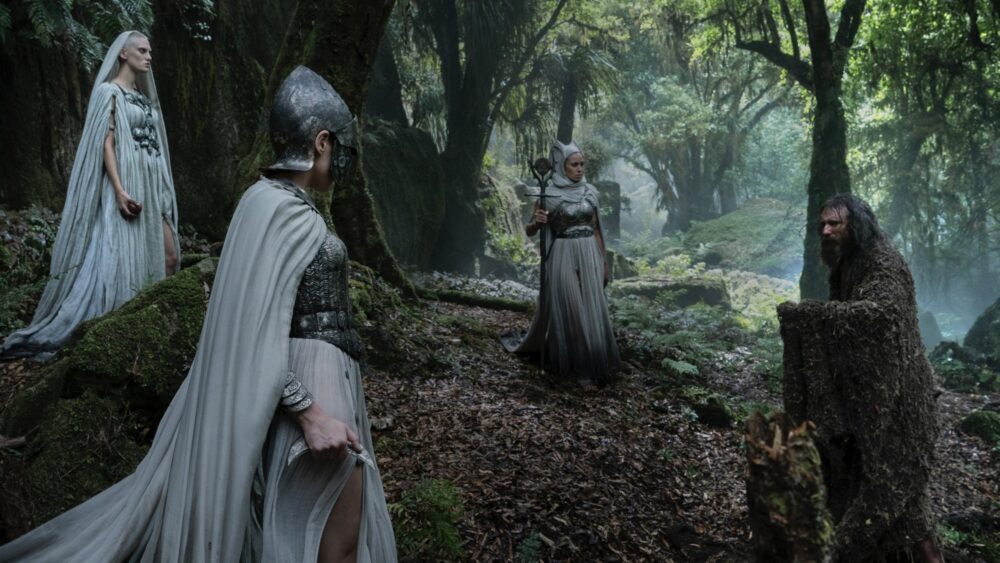Since the start of The Lord of the Rings: The Rings of Power, one of the show’s biggest mysteries has been: Who is the Stranger (Daniel Weyman)? Now, after the finale, we know. Kind of.
The Stranger crash-landed in Middle-earth in episode 1 and has been tagging along with Harfoot Nori Brandyfoot (Markella Kavenagh) ever since. Due to his memory loss, the only clues we really have about who he is are his appearance and his magical abilities — which have attracted the attention of a group of white-cloaked women known as the Mystics (Bridie Sisson, Kali Kopae, and Edith Poor).
Early in the Season 1 finale of The Rings of Power, the Mystics finally catch up to the Stranger and hail him as Lord Sauron. As we quickly learn throughout the rest of the episode, that isn’t true. Sauron is someone else entirely. The Mystics realize their mistake and a fight ensues, but the Stranger takes up one of their staffs, proclaims that he’s a force of good, and magics them away. As soon as the Mystics realize the Stranger isn’t Sauron, they label him an “Istar.” With this label, and several other hints throughout the episode and the season, The Rings of Power has all but confirmed that the Stranger is everyone’s favorite wizard: Gandalf the Grey. Let’s break it down.
What does Istar mean in The Rings of Power?

Credit: Ben Rothstein / Prime Video
As the Stranger begins to recall his memories after his encounter with the Mystics, he tells Nori that “Istar” means “Wise One,” or “Wizard.” However, Gandalf certainly isn’t the only wizard in Tolkien’s canon. In total, five Istari come to Middle-earth. Joining Gandalf are Saruman the White, Radagast the Brown, and two Blue Wizards. All five are Maiar, powerful spirits sent by the even more powerful Valar, who helped create the world.
In theory, the Stranger could be any one of these Istari, and it could be cool to see the never-seen-onscreen Blue Wizards in action. However, Gandalf is easily the most beloved and well-known of the five. If the Stranger is going to be any of the wizards, he’s going to be Gandalf. Plus, he wears all-grey, is fond of adventuring with the Hobbit-y Harfoots, and speaks to fireflies in a way that is reminiscent of how Ian McKellen’s Gandalf spoke with moths in Peter Jackson’s film trilogy. When he banishes the Mystics, a magical moth shape appears as well, further solidifying the connection.
But the clearest sign that the Stranger is Gandalf comes toward the end of the finale, when he and Nori are about to set off to the eastern land of Rhûn. Nori admits she has no idea where to go, but the Stranger picks a direction because the air smells sweeter that way. “If in doubt,” he tells her, “always follow your nose.”
If you’ve watched Jackson’s The Fellowship of the Ring, you’ve heard these words before. Gandalf directs them at Merry when they’re trekking through the Mines of Moria. Faced with a choice on which way to go, Gandalf chooses the way that smells freshest, uttering the line, “If in doubt, Meriadoc, always follow your nose.” Maybe nose-following is a common phrase among wizards, but I doubt it. The Stranger is Gandalf!
Interestingly, the line about following your nose does not appear in Tolkien’s books — although Gandalf does guide the Fellowship through Moria based on smell at one point. Does this mean Weyman’s Gandalf is just a younger version of McKellen’s? Will The Rings of Power link up to Jackson’s films? Or is this line just a sweet reference and my brain too full of fantasy IP to fully process? Whatever the truth, the line confirms suspicions that the Stranger is Gandalf, without outright having him say, “It’s me, Gandalf!”
If in doubt, always follow your nose.
Gandalf’s arrival during the Second Age of Middle-earth is a pretty big departure from Tolkien’s canon, which sees the Istari come to Middle-earth 1,000 years into the Third Age. The Valar send them to help stop the new rise of Sauron, although they are not allowed to confront him directly.
As we’ve seen throughout the season, The Rings of Power plays pretty fast and loose with Tolkien’s lore. The Stranger reveal is no exception. However, since the show is charting Sauron’s resurgence in the Second Age, it’s likely they’ve shifted the timeline so the Valar sent the Istari for the exact same purpose as in Tolkien’s work — just several centuries earlier. Once Stranger-Gandalf recovers his memories, perhaps we will actually see onscreen depictions of the Valar, and maybe the other wizards besides. We’ll just have to wait until he and Nori reach Rhûn to find out.












